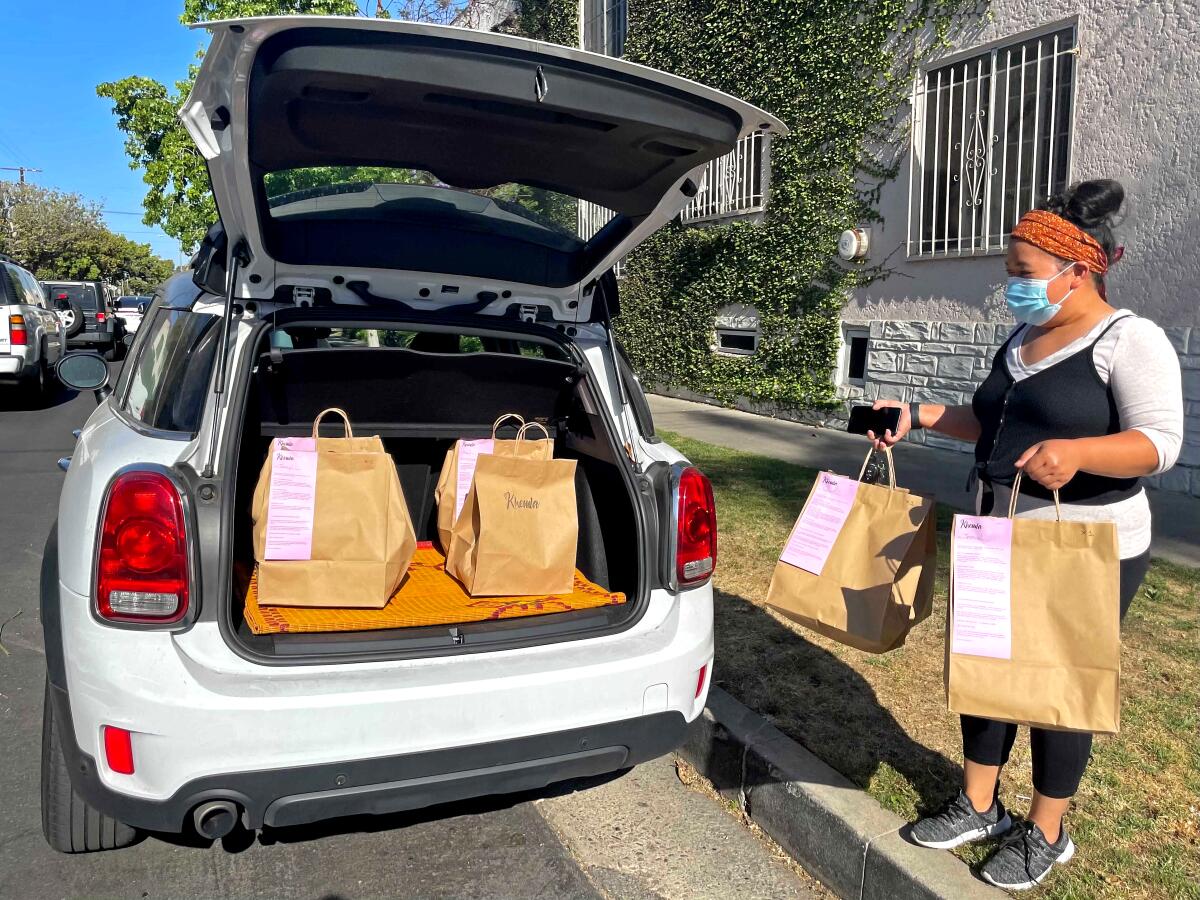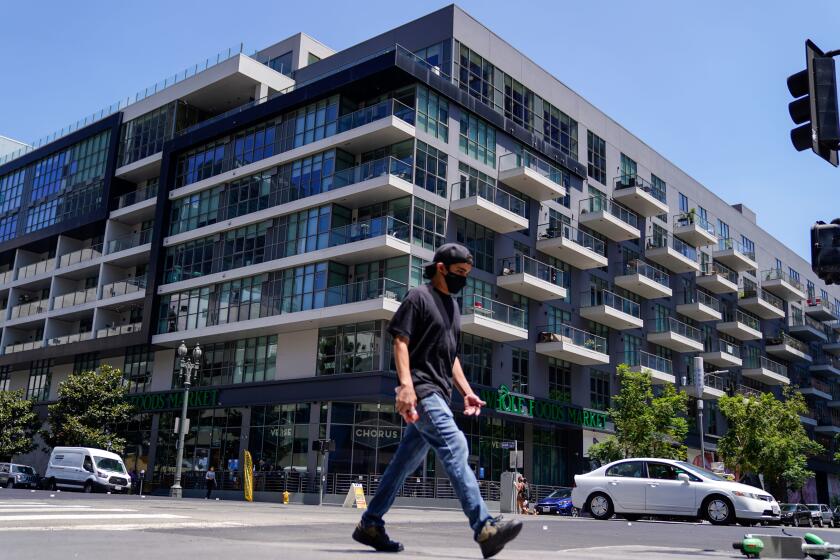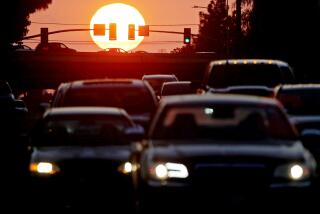As traffic rebounds in L.A., commuters say they won’t go back to the way things were

- Share via
It was the peak of the pandemic when Tiffanie Trinh was offered a job as an IT support technician for Taco Bell and told she could work remotely until further notice. Traffic was practically nonexistent at the time, but she dreaded the one-hour slog between her apartment in Long Beach and her new office in Irvine that awaited.
Her previous job had involved taking the notoriously traffic-choked 405 Freeway, and after working from her bedroom for months, she was loath to return to weekdays bookended by long stretches of time behind the wheel.
“I know it’s going to get worse when everything reopens,” Trinh, 22, recalls thinking. She began eyeing apartment listings in Orange County.
Sure enough, traffic has surged in recent weeks, already rebounding to near-normal levels in Los Angeles and other parts of California even before the state fully reopened Tuesday. That has prompted a collective sense of foreboding among people who have grown accustomed to working from home and are in no rush to get back to the daily gridlock grind.
Informed that they will be expected to return to the office at least part time, workers are scrambling to lessen or eliminate their former commutes by moving closer to work, negotiating new terms with their managers, switching jobs or quitting altogether.
Some pandemic-wrought changes to the business world seem lasting. (Work from home? Yes, thank you.) Others not so much. Here’s our guide to the new normal.
“I hated the evening drive home in the past,” said Dale Sieverding, who lives near the Grove and works as the director of worship at St. Monica Catholic Community in Santa Monica. “No matter if I came home at 2 o’clock or 7 o’clock, it was an hour.”
Sieverding worked remotely for 14 months, going back to the church three days a week in May after getting vaccinated. St. Monica has been gradually reopening, and employees have been talking to supervisors about the possibility of a hybrid workweek.
“We’re now evaluating as a staff. It’ll be hard to have a blanket policy,” Sieverding said. “My ideal would be to try to hold on to at least one day of working from home. It might be too much to ask for two.”
Even though overall traffic volumes are heavy again nationwide, new patterns have emerged this year, said Bob Pishue, an analyst at transportation data analytics company Inrix. Traffic is nearly at pre-pandemic levels on weekends and during the afternoon but down about 20% during the morning commute — possibly a reflection of school schedules being all over the place and many companies holding off on bringing employees back.
“Anecdotally, people are seeing all these cars on the road, but the times have shifted,” Pishue said. “It looks different throughout the day and throughout the week.”
Inrix also found geographic changes within cities, with less traffic in so-called downtown cores in L.A., San Francisco, New York and Washington, and a rise in traffic in the suburbs. “When people go back to work on a large scale is when those downtown trips will kick back in,” company spokesman Mark Burfeind said. “That’s when we’ll see congestion as we know it largely return.”
So much time just got wasted.... I can’t go back to the way it was before.
— Cat Dean, 28
For Phert Em, last year’s deserted streets opened up a business opportunity after she was furloughed from her restaurant job: She took her Cambodian food pop-up, Khemla, on the road.
Every week the chef posted a new menu on Instagram, selling three-course dinners for $40 that she cooked out of her Fairfax district apartment and loaded into the back of her white Mini Cooper. Zipping around town, Em delivered the meals to customers from Woodland Hills to Long Beach, Venice to the San Gabriel Valley. Delivery was included, and the drives took practically no time at all.
“It was a ghost town,” the 34-year-old said. “In the beginning, it was easy-peasy to do these deliveries.”
But in recent weeks, routes that used to take Em 25 minutes or less began exceeding an hour. Inching along the 101 Freeway to drop off two orders in Sherman Oaks, she’d had enough. “I can’t do this anymore,” she said. “There was no longevity in this business model.”
Em announced the end of her home delivery service last week, citing the resurgence in traffic as “the biggest factor.” She hopes to set up Khemla as a pop-up or residency at local bars and food festivals and eventually open her own restaurant.
Pent-up demand, pandemic savings, back-to-office mandates -- experts say it will all add up to a historic wave of people leaving their jobs.
Workers with particularly nightmarish commutes said stay-at-home orders brought about a new mindset: It doesn’t have to be this way.
To get to her job in Manhattan on time, Cat Dean used to leave her home in Yardley, Pa., at 6 a.m., drive 10 minutes to an Amtrak station in New Jersey, ride the train an hour to Penn Station, then take a subway half an hour to her office.
“So much time just got wasted,” she said — plus she was paying about $1,000 a month for parking, train fare and her subway pass. “I barely had enough money to do anything. But there was no way in hell I could afford New York.”
Dean, 28, worked from home for the first three months of the pandemic before being laid off from the music touring company where she worked as a program developer. Now self-employed, she’s juggling a handful of part-time jobs, including teaching, tarot reading and working as a spiritual practitioner.
Her former boss reached out saying he would hire her back once things improved, but her new lifestyle — ample sleep, unrushed mornings, better work-life balance and the confidence that productivity isn’t tied to an office setting — has become nonnegotiable.
“My physical and mental health blossomed being able to be at home,” Dean said. “I can’t go back to the way it was before. I know I can create better for me even if it takes time, and I’m going to choose that.”
She would consider a full-time job again, but “my one condition would have to be that it’s remote or no more than 30 minutes,” she said. “Commuting like that again, absolutely not. I will never do that again for anybody if I can help it.”
With California’s economy reopening, rent in Los Angeles and other big cities is beginning to rise.
Trinh, the Taco Bell IT worker, is still waiting to hear when she’ll have to go into the office. In the meantime, she moved into a two-bedroom apartment in Costa Mesa in January. Her new commute once work-from-home ends: as little as 10 minutes.
The prospect of traffic was “purely why I moved,” she said. “Logistically, it made more sense in the long run.”
More to Read
Inside the business of entertainment
The Wide Shot brings you news, analysis and insights on everything from streaming wars to production — and what it all means for the future.
You may occasionally receive promotional content from the Los Angeles Times.














